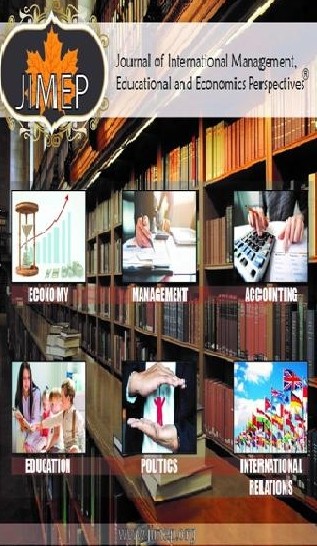LOJİSTİK PERFORMANS VE EKONOMİK BÜYÜME ARASINDAKİ İLİŞKİ: ORTA-DOĞU AVRUPA ÜLKELERİ VE TÜRKİYE ÖRNEĞİ
Bu çalışmanın amacı, İhracata Dayalı Büyüme (İDB) hipotezinin geçerliliğinin, Orta-Doğu Avrupa ülkeleri ve Türkiye için lojistik performansa bağlı olup olmadığını belirlemektir. Çalışma 2010-2016 dönemi için 9 Orta-Doğu Avrupa ülkesi ve Türkiye için dengeli panel verilerine dayanmaktadır. Analiz sonucu elde edilen bulgular, ihracata dayalı büyüme hipotezinin incelenen bütün ülkeler için geçerli olduğunu göstermektedir. Bu ülkeler için lojistik performans seviyesinde gözlemlenen olumlu bir gelişme ekonomik büyümeye katkı sağlamaktadır. Bundan dolayı politika karar vericiler ülkelerinin ekonomik büyümelerini artırmak için lojistik altyapıya yönelik yatırımları canlandırmaya çalışmalıdırlar.
Anahtar Kelimeler:
Lojistik Performans, Ekonomik Büyüme, İhracata Dayalı Büyüme
THE RELATIONSHIP BETWEEN LOGISTICS PERFORMANCE AND ECONOMIC GROWTH: EXAMPLE OF CENTRAL AND EASTERN EUROPE COUNTRIES AND TURKEY
The aim of this study is to determine whether the validity of the export-led growth (ELG) hypothesis depends on logistical performance for Central and Eastern European countries and Turkey. The study is based on balanced panel data for 9 Central and Eastern European countries and Turkey for the period 2010-2016. The results of the analysis show that the export-based growth hypothesis is valid for all countries examined. A positive development in the level of logistics performance for these countries contributes to economic growth. Policy decision makers should therefore seek to revive investment in logistical infrastructure to boost their country's economic growth.
Keywords:
Logistics Performance, Economic Growth, Export-Led Growth,
___
- Abosedra, S., ve Tang, C. F. (2019). Are exports a reliable source of economic growth in MENA countries? New evidence from the rolling Granger causality method. Empirical Economics, 56(3), 831-841.
- Afzal, M. (2006). Causality between exports, world income and economic growth in Pakistan. International Economic Journal, 20(1), 63-77.
- Ali, G., ve Li, Z. (2018). Exports-led growth or growth-led exports in the case of China and Pakistan: An empirical investigation from the ARDL and Granger causality approach. International Trade Journal, 32(3), 293-314.
- Apergis, N. ve Payne, J. E. (2010). A Panel Study of Nuclear Energy Consumption and Economic Growth, Energy Economics, 32: 545–549.
- Bahmani-Oskooee, M., ve Alse, J. (1993). Export growth and economic growth: An application of cointegration and error-correction modeling. Journal of Developing Areas, 27(4), 535-542.
- Bahmani-Oskooee, M., Mohtadi, H., ve Shabsigh, G. (1991). Exports, growth and causality in LDCs: A re-examination. Journal of Development Economics, 36(2), 405-415.
- Darrat, A. F. (1986). Trade and development: The Asian experience. Cato Journal, 6(2), 695-699.
- Dritsakis, N. (2004). Exports, Investments and Economic Development of preaccession countries of the European Union: an empirical investigation of Bulgaria and Romania, Applied Economics, 36, 1831-1838.
- Furuoka, F. (2007). Econometric analysis of the export-led growth hypothesis: Evidence for BIMP-EAGA countries. Philippines Journal of Development, 63(2), 25-42.
- Grosmann, G.M. ve Helpman, E. (1991). Innovation and growth in the global Cambridge MIT Press.
- Hesse, M., ve Rodrigue, J. P. (2006). Global production networks and the role of logistics and transportation. Growth and Change, 37, 499-509.
- Hummels, D. (1999). Have international transportation costs? Department of economics working paper. (USA): Purdue University.
- Hye, Q. M. A., Wizarat, S., ve Lau, W. Y. (2013). Trade-led growth hypothesis: An empirical analysis of South Asian countries. Economic 35, 654-660.
- Ibrahim, M. H. (2002). An empirical note on the export-led growth hypothesis: The case of Malaysia. Economic Analysis and Policy, 32(2), 221-232.
- Im, K. S., Pesaran, M. H., ve Shin, Y. (2003). Testing for unit roots in heterogeneous panels. Journal of Econometrics, 115, 53–74. https://doi.org/10.1016/S0304-4076(03)00092-7.
- Jung, W. S., ve Marshall, P. J. (1985). Export growth and causality in developing countries. Journal of Development Economics, 18(1), 1-12.
- Konya, L. (2004). Export-Led Growth, Growth-Driven Export, Both or None? Granger Causality Analysis on OECD Countries, Applied Econometrics and International Development, 4, 73-94.
- Krueger, A. (1980). Trade policy as an input to development. American Economic Review, 70, 288-292.
- Kwan, A. C. C., ve Kwok, B. (1995). Exogeneity and the export-led growth hypothesis: The case of China. Southern Economic Journal, 61(4), 1158-1166.
- Love, J., ve Chandra, R. (2005). Testing export-led growth in South Asia. Journal of Economic Studies, 32(2), 132-145.
- Mariotti, I. (2015). Transport and logistics in a globalizmg world. New York: Springer.
- Shan, J., ve Sun, F. (1998). On the export-led growth hypothesis for the little dragons. An empirical reinvestigation. Atlantic Economic Journal, 26(4), 353-371.
- Sharif, A., Shahbaz, M., ve Hille, E. (2019). The transportation-growth nexus in USA: Fresh insights from pre-post global crisis period. Transportation Research Part A: Policy and Practice, 121, 108-121.
- Yang, M. H., ve Wu, C. S. (2015). Revisit export and GDP nexus in China and Taiwan: A rolling window Granger causality test. Theoretical and Applied Economics, 22(3), 75-92.
- Başlangıç: 2013
- Yayıncı: Ahmet GÜVEN
Sayıdaki Diğer Makaleler
Emre YAZICI, İlkut Elif KANDİL GÖKER
Yusuf AKGÜL, Fuat ÇAMLIBEL, Ahmet ŞENGÖNÜL
BANKA FİNANSAL RİSKLERİNİN BANKA KARLILIĞINA ETKİSİ
Zekai ŞENOL, Meryem Öncül, Muhammed Said Alıcı
İL TURİZMİNİN POTANSİYELİNİN ARTMASINDA YEREL KONAKLAMA TESİSLERİNİN ETKİNLİĞİNİN ÖLÇÜLMESİ
Gülistan BAŞCI, Eşref Savaş BAŞCI
SİGORTACILAR İÇİN DÖVİZ KURU RİSKİNE YÖNELİK STRES TESTİ UYGULAMASI
PEKANBARU'NUN ASH-SHOFA EĞİTİM ENSTİTÜSÜ'NDE ÖĞRETMENİN PROFESYONEL GELİŞİMİN ÖNEMİ
